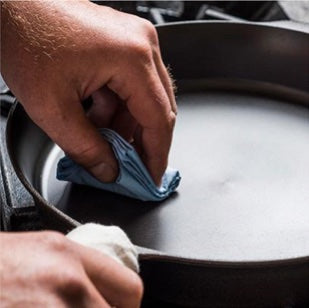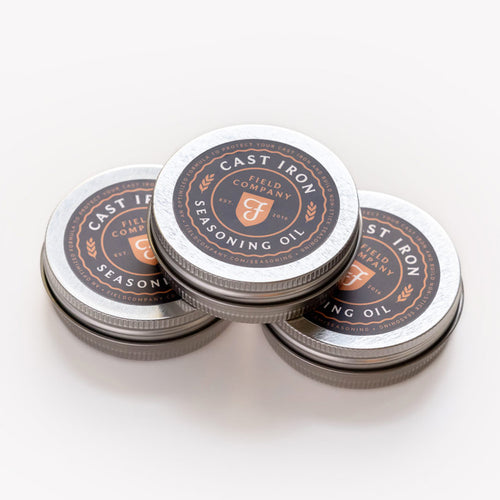One of the most important things to know about cast iron is that it’s extremely resilient. Have you ever thought you ruined a cast iron skillet? Don’t worry, you didn’t. In almost every situation, the solution to any problem you’re having with a cast iron pan is to JUST KEEP COOKING.

But we understand that sometimes even the most experienced cast iron users need a little reassurance. Scroll down to see some photos of the most common cast iron problems (which can happen with any pan, vintage or new), and our prescription for every scenario.
Cast Iron Discoloration

When you begin using a new cast iron skillet, it’s likely that its cooking surface will become patchy or uneven in color. This is totally normal and expected for a new cast iron skillet, especially a higher-quality one with a smooth surface. Cast iron becomes naturally non-stick with time and use, by developing many thin, interlocking layers of seasoning on its surface. Each time you cook in your skillet, it will gain and lose seasoning in different spots, which can cause some discoloration in the beginning. But as you develop more and more seasoning across the surface of the pan, you’ll see its color even out and darken overall. If you’re having trouble with this breaking-in process, we recommend using a little extra oil or fat, and regularly making some recipes that will add seasoning to your cast iron skillet.
Flaking Seasoning

Field Skillets don’t have any artificial coatings, so if you see something like the above, you might wonder, “what’s coming off the surface of my pan?” Just as seasoning builds up on the surface of your skillet, it can also come off. This usually happens when you have too many thick layers of seasoning built up, or if you season your skillet with certain types of oil, like flaxseed. Seasoning your skillet in the oven can create these thick layers that are prone to flaking, which is why we don’t typically recommend it. Sometimes flaking seasoning can just be caused by cooking the wrong thing, like an acidic sauce or a salty broth. Even if you’re an experienced cast iron user and have never dealt with flaky seasoning before, it can still happen. Luckily, flaky seasoning is a pretty easy fix! First, we recommend giving your cast iron skillet a good scouring with a chain mail scrubber, steel wool or the edge of a metal spatula. Pay attention to any areas with loose or flaky seasoning, you want to remove anything that will easily come off the pan. After that, clean and dry your pan as usual. From there, the real solution is to JUST KEEP COOKING. With time and plenty of use, your skillet will develop new seasoning, which will gradually fill in any bare patches, while regularly scouring it with a chain mail scrubber will prevent flaking in the future. If you don't want to use chain mail you could also try cleaning your cast iron with salt!
Oil Residue & Splotchy Seasoning

How do you fix a badly seasoned cast iron pan? If you see some raised, splotchy residue on your skillet, which often looks like a spiderweb or spotted pattern, this is most likely some oil residue. This sticky situation can occur when you season your pan with a little too much oil, or if some oil hasn’t fully polymerized and turned into seasoning yet. Unwanted oil residue is an easy thing to tackle: if these spots are sticky, heat your pan over medium heat for a few minutes. Before they get sticky, you can also try wiping with a paper towel. You won’t see the oil residue disappear, but after turning the heat off and letting your pan cool, the surface should be less sticky. Once you’ve minimized the stickiness, continuing to cook in your cast iron skillet will solve the problem. New seasoning will gradually incorporate these marks, and you’ll see the surface even back out with plenty of use.
Rust

Sometimes rust happens, and it doesn’t mean your pan is ruined. There is only one thing that causes rust, moisture; even something as simple as not drying your pan thoroughly can result in a little rust. Addressing rust is pretty easy: you need to scrub it off under cold water, then begin building up some new seasoning on your pan. We recommend removing rust by scrubbing your pan with a stiff brush or a scouring pad. Rinsing your skillet with cold water while cleaning off rust will help prevent new rust from forming quickly. After scrubbing and rinsing your skillet, make sure you dry it thoroughly by heating it for a few minutes on the stovetop. Once dry, coat the skillet all over in a thin layer of seasoning oil. Covering your pan with seasoning oil after every use—and using your pan frequently—will protect it from developing more rust in the future.
Scratched Seasoning

Seasoning can get scratched if you cut something directly in your cast iron skillet, or even if you use a metal utensil at the wrong angle. But it’s not a big deal, and it doesn’t mean you can’t use metal tools in your cast iron skillet. (If you bake a pie in your pan, it makes sense that you’d want to cut and serve it from the skillet! Read our guide to when to use metal vs wood utensils in your cast iron. ) To fix scratched seasoning, you really don’t need to do anything except JUST KEEP COOKING. These scratches will fill in with new seasoning as you keep using your pan, and you’ll see them disappear eventually. This is another time where making recipes that are great for seasoning will help speed up the process of evening your skillet surface back out.
Stripped Seasoning

If your pan looks like one of the pictures above, you’ve stripped away a good amount of seasoning. So how do you fix a pan with stripped seasoning? This might look intimidating, but remember that you really can’t ruin cast iron. Even if you strip away most of the seasoning, you can still rebuild it into the sleek, nonstick skillet you expect. (To avoid stripping your seasoning like this in the first place, we recommend only cooking acidic ingredients or liquidy braises in a pan that has plenty of good seasoning on it.) So you stripped your skillet? Gently wash your pan to remove any loose seasoning or residue, do two or three rounds of following our oven seasoning instructions, and then JUST KEEP COOKING. In cases like this some oven seasoning can be helpful for jumpstarting the re-seasoning process, although we don’t often recommend seasoning your skillet in the oven.





